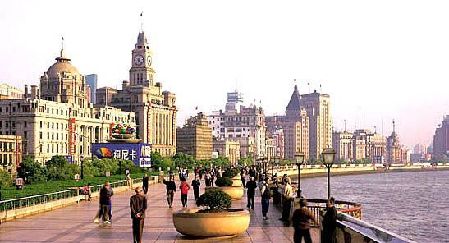The Bund

Overview
Of all the sights evocative of the splendor and decadence of old Shanghai, none is singularly more impressive than the Bund. Getting its name from an Anglo-Indian word meaning "muddy embankment," the Bund rolls down a million dollar mile along the west bank of Shanghai's most essential waterway, teh Huangpu River. It's on this swampy riverbank where Shanghai's previous taipans erected these monuments of wealth. The Bund still remains Shanghai's number one tourist site and with all the things to see in Shanghai, this is the one that can't be missed. Running the length of the Bund is Zhongshan East Road, a major thoroughfare that can be crossed by tunnels or pedestrian bridges.
Know More
During the 1920's and 30's, the Bund served as the focal point for the thriving city's financial and social life. The great edifices built here held great symbolic importance. When junks and cargo ships reached Shanghai, this promenade along Shanghai's waterfront was the first sight they would see. If any doubted the economic prowess Shanghai enjoyed during those times, the buildings along the Bund quickly disposed of any notions that the city was a pretender. From their windows overlooking the teeming Huangpu, Shanghai's wealthy could watch with baited breath as their cargoes of opium, gold and silver bullion, tea and spices were loaded on and off their ships.
Built of marble and stone, the Bund is emblematic of foreign interest and business anchored in Shanghai's staying power. They also served to assure Shanghai's foreigh residents and visitors as to who was in control. By night, away from the brothels and opium dens lining the Bund's auxiliary streets, Shanghai's richest met in the British and French Clubs to quaff whiskey sours while Shanghai's endless night burnt to its wick.
Although things are different now, the buildings of the Bund retain much of their previous grandeur. To prevent flooding from the Huangpu and Suzhou Creek, the promenade was raised from a simple street to an elevated, cement walkway. As one of Shanghai's few free tourist attractions, it's regularly thronged with both domestic and international tourists. Hawkers sell glow sticks and light-up toys by night while photographers offer to capture your magic moment backlit by either Pudong's futuristic skyline or the Bund's colonial massif. The best place to view the Bund is from the walkway along the river's edge; from here you can take in the view of the old masterpieces and the new wonders across the river.
Must See
Today's Bund is as evocative of Shanghai's yesteryears with hints of the city's tomorrow. The once teeming wharves have been moved further downstream, though the Bund is still a great place to view the Huangpu River's ship traffic. When the foreigners left, control of the buildings was assumed by the state though very few continued to perform their original functions. The Peace Hotel, the AIA Building and the Shanghai Customs House, though no longer holding the eminent prestige of the past, have persisted throughout the march of time.
The northern end of the Bund begins just south of the Garden Bridge.Despite being north of the of the bridge the Park Hotel, the Astor House Hotel and Russian Consulate are worth visiting.
At the Bund's northern end stands the Monument to the People's Heroes. At its base is the Bund History Museum where visitors can gaze at a colection of photoes from Shanghai's old days.
















